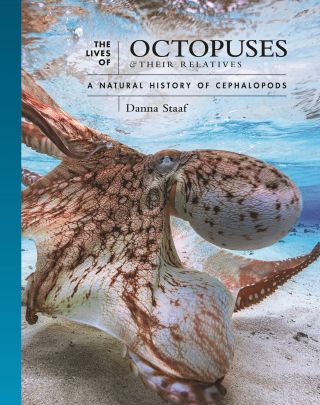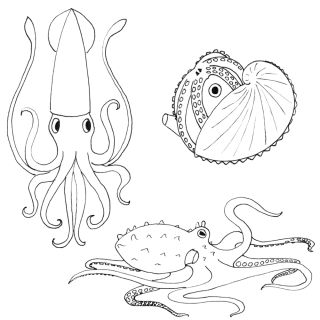Animal Behavior
Octopuses: The Fascinating Lives of Sensitive, Clever Beings
Dr. Danna Staaf discusses her new book about cephalopods.
Posted September 13, 2023 Reviewed by Ray Parker
Key points
- "The Lives of Octopuses and Their Relatives" is a comprehensive guide to the natural history of cephalopods.
- The author, Danna Staaf, is a marine biologist and science writer.
- The book highlights the importance of cephalopods in marine ecosystems; they play a vital role in the ocean.

Octopuses and other cephalopods are amazing, strange, sentient beings. They have very active social lives and brains—some say octopuses have nine brains, one in each arm and one in their head—and are highly diverse. Their welfare is also protected by law in some countries and there are restrictions on how they can be used in invasive, painful research.1
I don't know all that much about these wonderful animals and was thrilled to learn of a new beautifully written and illustrated book by author, artist, and marine biologist, Danna Staaf, called The Lives of Octopuses and Their Relatives: A Natural History of Cephalopods.2
Here's what Danna had to say about her new book.
Marc Bekoff: Why did you write The Lives of Octopuses and Their Relatives and how does your book relate to your background and general areas of interest?
Danna Staaf: This is the book I looked for and couldn’t find when I first fell in love with octopuses as a child. The ten-year-old inside me is thrilled that I got to grow up and write it. To be clear, The Lives of Octopuses isn’t a children’s book (that wasn’t what I was looking for). It’s a thorough exploration of my favorite group of animals, written in language that doesn’t require a science degree to understand but with enough detail to satisfy the most avid curiosity. As a kid, the closest I could find to something like this was Jacques Cousteau’s Octopus and Squid: The Soft Intelligence. That was a great read, but it focused as much on the film crew’s adventures as their documentation of octopuses themselves. And it was published in 1973, which made it a couple of decades out of date, even when I was 10. These days, of course, the library shelves look a bit different.

MB: How does your book differ from others that are concerned with some of the same animals?
DS: The modern reader has a wealth of fantastic cephalopod books to choose from, from Sy Montgomery’s The Soul of an Octopus to Wendy Williams’ Kraken and my own Monarchs of the Sea. Many of these are narrative nonfiction, books that tell true stories. Stories of scientific research, aquatic adventure, and even personal discovery. The Lives of Octopuses is less narrative and more informational: full of descriptions, facts, diagrams, and photos. You don’t need to read it sequentially—you can pick a chapter based on what environment interests you (tide pools? coral reefs? Antarctica?), or search the index for your favorite species.
It’s certainly not the first informational text about cephalopods for general readers—another notable example is Octopus, Squid, and Cuttlefish: A Visual, Scientific Guide To the Ocean's Most Advanced Invertebrates by Roger Hanlon, Mike Vecchione, and Louise Allcock, which came out in 2018. That one is similarly packed with gorgeous images and detailed descriptions. The difference between the two is really captured in the subtitles: Octopus, Squid, and Cuttlefish is a “scientific guide,” while The Lives of Octopuses and Their Relatives is a “natural history.” That doesn’t mean the first book is unnatural, or that the second book is unscientific. It’s simply a difference in focus.
For Lives of Octopuses, I wrote at least as much about the various environments and habitats of cephalopods as about the animals themselves. I wanted to bring readers into the sand flats, the kelp forests, and the deep trenches, to meet the cephalopods in their own homes. Also, when picking species to profile, I went fishing for more unusual species and wound up with oddballs, like the Star-Sucker Pygmy Octopus and the Luminous Bay Squid.
MB: What are some of the topics you weave into your book and what are some of your major messages?
DS: I really wanted to showcase the group, and each species, as integral to their environment. No life exists in a vacuum; every organism has come to its physical shape and its place in the world through endless interactions with others. Cephalopods in particular are often at the center of marine food webs, predators on everything smaller than them and prey to everything larger. There’s a section in the book called, “Why plants (and algae) matter to predators,” where I talk about how cephalopods don’t eat kelp but they hide in it, camouflage as it, and eat animals that depend on it. I got to write about how the sand octopus uses muscle and mucus to reshape its environment, and how the albatrosses make a living thanks to the spawn-and-die lifestyle of oceanic squid.
I also wanted to explain aspects of cephalopod biology that I never fully understood myself before tackling this book. How exactly does an octopus sucker work? I read half a dozen academic papers on this subject so I could summarize it, and helped an artist draw a realistic diagram of these tiny amazing organs.
The Lives of Octopuses and Their Relatives mentions many of the mysteries that cephalopods still hold, too. As fascinating as these creatures are and as much as we've learned about them, we also keep opening new avenues of inquiry. What are squid slime and octopus venom made of? Why do some cephalopods have such strangely-shaped babies? I think one of the most beautiful parts of science is finding that we don't yet have all the answers.
References
In conversation with science communicator, author, artist, and marine biologist, Dr. Danna Staaf. Danna is the author of Monarchs of the Sea: The Extraordinary 500-Million-Year History of Cephalopods (named one of Science Friday's best science books of the year), The Lady and the Octopus: How Jeanne Villepreux-Power Invented Aquariums and Revolutionized Marine Biology (a best book of the year of the School Library Journal and the Children's Book Committee), and Nursery Earth: The Wondrous Lives of Baby Animals and the Extraordinary Ways They Shape Our World (hailed as "a gobsmacking delight!").
1) For more discussion of cephalopod sentience and legal protections click here.
2) The book's description reads, "Dive deep into the fascinating world of cephalopods—octopuses, squid, cuttlefish, and the mysterious nautilus—to discover the astonishing diversity of this unique group of intelligent invertebrates and their many roles in the marine ecosystem. Organized by marine habitat, this book features an extraordinary range of these clever and colorful creatures from around the world and explores their life cycles, behavior, adaptations, ecology, links to humans, and much more. With stunning photographs and illustrations as well as profiles of selected species, The Lives of Octopuses and Their Relatives is a comprehensive, authoritative, and inviting introduction to the natural history of these charismatic creatures."
What Is It Like to Be an Octophant?; Cephalopods: The Fascinating Lives of Sensitive Beings.


